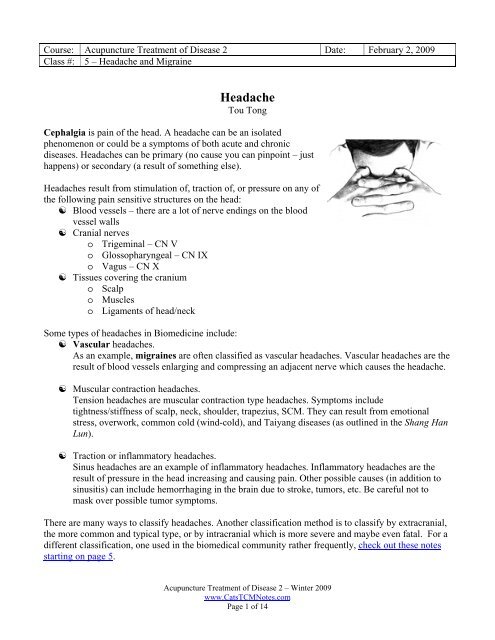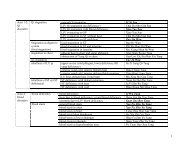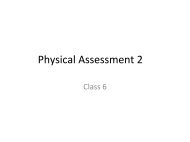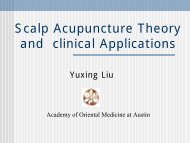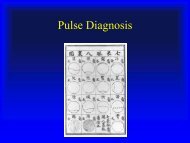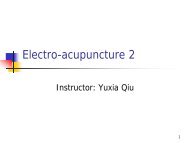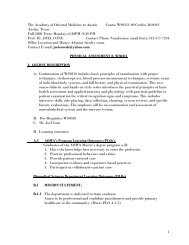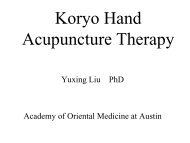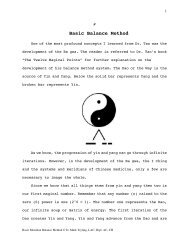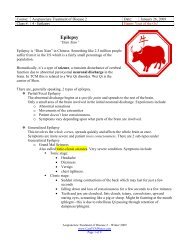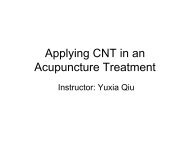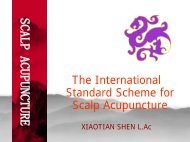Headache - CatsTCMNotes
Headache - CatsTCMNotes
Headache - CatsTCMNotes
Create successful ePaper yourself
Turn your PDF publications into a flip-book with our unique Google optimized e-Paper software.
Course: Acupuncture Treatment of Disease 2 Date: February 2, 2009<br />
Class #: 5 – <strong>Headache</strong> and Migraine<br />
<strong>Headache</strong><br />
Tou Tong<br />
Cephalgia is pain of the head. A headache can be an isolated<br />
phenomenon or could be a symptoms of both acute and chronic<br />
diseases. <strong>Headache</strong>s can be primary (no cause you can pinpoint – just<br />
happens) or secondary (a result of something else).<br />
<strong>Headache</strong>s result from stimulation of, traction of, or pressure on any of<br />
the following pain sensitive structures on the head:<br />
☯ Blood vessels – there are a lot of nerve endings on the blood<br />
vessel walls<br />
☯ Cranial nerves<br />
o Trigeminal – CN V<br />
o Glossopharyngeal – CN IX<br />
o Vagus – CN X<br />
☯ Tissues covering the cranium<br />
o Scalp<br />
o Muscles<br />
o Ligaments of head/neck<br />
Some types of headaches in Biomedicine include:<br />
☯ Vascular headaches.<br />
As an example, migraines are often classified as vascular headaches. Vascular headaches are the<br />
result of blood vessels enlarging and compressing an adjacent nerve which causes the headache.<br />
☯ Muscular contraction headaches.<br />
Tension headaches are muscular contraction type headaches. Symptoms include<br />
tightness/stiffness of scalp, neck, shoulder, trapezius, SCM. They can result from emotional<br />
stress, overwork, common cold (wind-cold), and Taiyang diseases (as outlined in the Shang Han<br />
Lun).<br />
☯ Traction or inflammatory headaches.<br />
Sinus headaches are an example of inflammatory headaches. Inflammatory headaches are the<br />
result of pressure in the head increasing and causing pain. Other possible causes (in addition to<br />
sinusitis) can include hemorrhaging in the brain due to stroke, tumors, etc. Be careful not to<br />
mask over possible tumor symptoms.<br />
There are many ways to classify headaches. Another classification method is to classify by extracranial,<br />
the more common and typical type, or by intracranial which is more severe and maybe even fatal. For a<br />
different classification, one used in the biomedical community rather frequently, check out these notes<br />
starting on page 5.<br />
Acupuncture Treatment of Disease 2 – Winter 2009<br />
www.<strong>CatsTCMNotes</strong>.com<br />
Page 1 of 14
Treatment is often a combination of pain relievers, anti-inflammatories, inhalers, antibiotics, etc.<br />
Symptoms of a headache when described in biomedical terms include location of pain, nature of pain<br />
and inducing factor.<br />
☯ Throbbing or dull pain?<br />
☯ Nausea? Vomiting?<br />
☯ Blurred vision?<br />
☯ Tender scalp?<br />
☯ Sensitivity to light, odors, and noise?<br />
Yes to these questions can help determine a migraine status.<br />
Types of headaches per TCM Classification<br />
Type Channels Location Etiology Guiding herbs<br />
Taiyang SI, UB Occiput ☯ Wind<br />
☯ Wind-Cold<br />
☯ Stress<br />
☯ Ma Huang<br />
☯ Ge Gen<br />
☯ Qiang Huo<br />
Shaoyang SJ, GB Temporal ☯ Damp Heat in GB ☯ Chai Hu<br />
☯ LV Yang<br />
Yangming LI, ST Forehead ☯ Yangming disease<br />
i.e., external pathogen<br />
invasion – sinus<br />
headache<br />
☯ Irregular diet<br />
Coffee, alcohol, etc.<br />
Jueyin PC, LV Vertex ☯ LV Blood Xu<br />
☯ Cold in LV channel<br />
All-over<br />
headaches<br />
☯ Huang Qin<br />
☯ Bai Zhi<br />
☯ Shi Gao<br />
☯ Sheng ma<br />
☯ Gao Ben<br />
☯ Xi Xin<br />
☯ Wu Zhu Yu<br />
(Cold in LV ch)<br />
☯ Chuan Xiong*<br />
*Chuan Xiong is the most basic herb for all types of headaches…Chuan Xiong Cha Tiao San formula<br />
works for allergic and external invasion headaches. Drink 3-5 grams in powder form with green tea.<br />
TCM Etiology<br />
Five etiologies to know regarding headaches in TCM:<br />
☯ Invasion of external pathogens<br />
o Pressure: wind<br />
o Temperature: cold or heat<br />
o Humidity: dry or damp<br />
You can therefore have headaches with patterns such as wind cold, wind heat, wind damp, wind<br />
dryness, etc.<br />
Acupuncture Treatment of Disease 2 – Winter 2009<br />
www.<strong>CatsTCMNotes</strong>.com<br />
Page 2 of 14
☯ Emotional disorders<br />
o Liver – more deficiency related headaches<br />
o Gall Bladder – more excess related<br />
☯ Irregular diet<br />
Overconsumption of spicy foods, alcohol, coffee, etc.<br />
☯ Overworking<br />
Consumes yin, leading to an imbalance of yin/yang<br />
☯ Trauma<br />
TCM Mechanism<br />
Blockage of channels in the head<br />
with disorder of Shi (excess) and Xu in the upper and lower parts of the body.<br />
<strong>Headache</strong>s are a Channel syndrome and 2/3 of them are excess in nature. Channels that flow through or<br />
on the head include:<br />
☯ The 6 regular Yang channels<br />
☯ Ren channel<br />
☯ Du channel<br />
☯ Yin Qiao channel<br />
☯ Yang Qiao channel<br />
☯ Liver<br />
which is a yin organ with yang functions.<br />
TCM Differential Diagnoses and Treatments<br />
Differential diagnoses for headaches are a mix of excess/deficiency and internal/external.<br />
External evils are excess in nature and are the invasion of external pathogens such as wind-cold, windheat<br />
and wind-damp.<br />
Internal evils causing headaches can be excess or deficient. Excesses are Liver Yang/Fire, Turbid<br />
Phlegm and Inner Wind, and Blood Stasis. Deficiencies are Blood xu and Kidney xu.<br />
Basic Points to treat <strong>Headache</strong>s<br />
☯ GB 20 is suitable for headaches of any kind, including migraines. It also expels wind for<br />
headaches of either external wind or internal wind.<br />
Acupuncture Treatment of Disease 2 – Winter 2009<br />
www.<strong>CatsTCMNotes</strong>.com<br />
Page 3 of 14
☯ Du 20 balances Yang Qi. Also good for one-sided headaches, vertex headaches, wind in the<br />
head including that which induces dizziness.<br />
☯ Taiyang extra point treats headaches and migraines in the temporal region (best to combine it<br />
with distal points). Also eliminates wind and heat.<br />
☯ Yintang treats frontal headaches.<br />
☯ LU 7 + LI 4 host/guest combination. Together these also balance the Yang.<br />
o LU 7 is the command point for the head and nape of the neck; addresses headaches, stiff<br />
neck and nape, one-sided headaches.<br />
o LI 4 is the command point for the face and mouth. Good for headaches, one-sided<br />
headaches and whole-head headaches.<br />
☯ UB 10 to treat stiff neck and occipital headaches. Activates and alleviates pain of the Taiyang<br />
channel. Deadman says it addresses pain and heaviness of the head, headache, wind affecting<br />
the head, inability to turn the head due to stiffness in the neck.<br />
☯ SJ 3 activates the SJ channel and alleviates pain. It is used for one-sided headaches and pain<br />
in the temples. The San Jiao channel is closely associated with the Shaoyang channels, so<br />
assists in treating Shaoyang headaches.<br />
☯ SI 3 benefits the occiput, back and neck, activates the channel and alleviates pain. It is<br />
indicated for stiffness and pain with difficulty turning the neck to one side. It is also useful<br />
for bilateral pain and pain in the shoulder and upper back.<br />
Taiyang <strong>Headache</strong>s GB 20, UB 10, SI 3<br />
Shaoyang <strong>Headache</strong>s Taiyang and SJ 3<br />
Yangming <strong>Headache</strong>s Yintang extra point<br />
Jueyin <strong>Headache</strong>s Du 20, LU 7, LI 4<br />
Generally: For acute headaches acupuncture is better and faster than herbs. If there is a heavy<br />
sensation that goes to the forehead and eye area when needling GB 20 the patient’s headache<br />
should be greatly relieved after the treatment.<br />
Wind-Cold Invasion <strong>Headache</strong><br />
This is an external excess headache caused by invasion of external pathogens. This type of<br />
headache is a Taiyang headache and affects the occiput and below.<br />
UB 12 and 13 as well as SJ 17 help to expel wind. Moxa warms the channels and helps expel the<br />
cold.<br />
Acupuncture Treatment of Disease 2 – Winter 2009<br />
www.<strong>CatsTCMNotes</strong>.com<br />
Page 4 of 14
Wind-Heat Invasion <strong>Headache</strong><br />
This is an external excess headache caused by invasion of external pathogens. This type of<br />
headache is a Yangming headache affected the forehead region and below.<br />
Wind-Damp Invasion <strong>Headache</strong><br />
This is an external excess headache caused by invasion of external pathogens. This type of<br />
headache affects the temporal region or whole head and is a Shaoyang headache.<br />
Acupuncture Treatment of Disease 2 – Winter 2009<br />
www.<strong>CatsTCMNotes</strong>.com<br />
Page 5 of 14
Liver Yang Rising and Flaring up of Liver Fire<br />
This is an internal excess headache. It affects either the vertex (LV) or temporal area (GB).<br />
Know these symptoms!<br />
Retention of Turbid Phlegm and Inner Wind<br />
This is an internal excess headache. It is primarily though not exclusively a temporal headache.<br />
Acupuncture Treatment of Disease 2 – Winter 2009<br />
www.<strong>CatsTCMNotes</strong>.com<br />
Page 6 of 14
Retention of Blood (Xue) Stasis<br />
This headache is one of internal excess and can be either acute or chronic. Location can be<br />
anywhere on the head.<br />
Blood Deficiency (Xu)<br />
This is an internal deficient headache and is chronic in nature. It is related to anemia, irregular<br />
menstrual cycle with heavy bleeding and post-partum bleeding. <strong>Headache</strong>s are Jueyin headaches<br />
and may be felt at the vertex or internally.<br />
Acupuncture Treatment of Disease 2 – Winter 2009<br />
www.<strong>CatsTCMNotes</strong>.com<br />
Page 7 of 14
Kidney Xu of Essence or Yin<br />
This is an internal deficiency and is associated with a Jueyin headache around Du 15 and Du 16.<br />
Know these symptoms!<br />
Acupuncture Treatment of Disease 2 – Winter 2009<br />
www.<strong>CatsTCMNotes</strong>.com<br />
Page 8 of 14
Migraine<br />
Pian Tou Tong or “unilateral head pain”<br />
Biomedically, migraines are defined as a biological<br />
disorder of the CNS. The most common type of<br />
migraine is of vascular nature and is due to a rapid<br />
change in the size of blood vessels. Somewhere in the<br />
neighborhood of 25million people suffer from<br />
migraines annually, according to a 1999 study. That<br />
breaks down to 20% of women and 11% of men that<br />
will experience at least one migraine in their lifetimes.<br />
Cost in medical care and productivity loss combined is<br />
more than $17billion per year.<br />
The biomedical mechanism causing migraines is an<br />
insufficiency of serotonin. Serotonin is a<br />
neurotransmitter – the equivalent of Wei Qi as the<br />
carrier of Shen – and plays a significant role in the<br />
contraction and expansion of blood vessels.<br />
Migraine triggers include:<br />
☯ Bright lights and sunshine<br />
☯ Diet factors including MSG,<br />
chocolate, red wine, etc.<br />
☯ Noises – loud or noisy sounds<br />
☯ Stress<br />
☯ Various smell triggers<br />
☯ Fluctuation of hormones<br />
☯ Changes in barometric pressure<br />
☯ Chemical sensitivities and pollution<br />
☯ Trauma<br />
☯ Lots more…<br />
Symptoms:<br />
The following list contains both symptoms and the measures by which one is classified as a migraine<br />
sufferer for biomedical purposes:<br />
☯ Patient has had at least 5 headaches with similar features lasting 4 – 72 hours per episode.<br />
☯ <strong>Headache</strong>s are of moderate to severe intensity and last 2 – 72 hours<br />
☯ Throbbing, pulsating pain<br />
☯ Initially begin as unilateral headaches (typically)<br />
☯ Pain is worse with activity (walking, exercise, esp going up/down stairs, bending over, etc.)<br />
☯ Pain is often accompanied with nausea/vomiting<br />
☯ Sensitivities to:<br />
o Light (photophobia)<br />
o Sound (phonophobia)<br />
o Smells (osmophobia)<br />
☯ Family history of migraines (in TCM this is reflective of a Kidney Essence Xu)<br />
☯ Cyclical pattern – tend to recur cyclically<br />
Migraines are classed into two types in the biomedical model: common migraines and classic migraines.<br />
Acupuncture Treatment of Disease 2 – Winter 2009<br />
www.<strong>CatsTCMNotes</strong>.com<br />
Page 9 of 14
☯ Classic migraines have auras, a visual pattern of colors and/or visual disturbances that look<br />
like lines around what the patient sees. Classic migraine sufferers often have early signs that<br />
a migraine is coming on which could be dizziness, mild nausea, etc. Classic migraines are<br />
experienced by 15-40% of migraine patients.<br />
☯ Common migraines come without any early warnings such as the auras. These are far more<br />
common and account for 60-85% of all migraines experienced.<br />
The differences between headaches and migraines.<br />
Though a migraine could be a two-sided headache, for more commonly they are one-sided. Twosided<br />
headaches would be a sub-category of headaches. Migraines are associated with more<br />
throbbing pain, sensitivity to light, cyclical patterns and are far longer in duration than<br />
headaches. A migraine might last as little as 4 hours or as long as 72 and is often vascular.<br />
Migraines also often have digestive problems and visual disturbances up to and during the<br />
migraine.<br />
Migraines are associated with blood dysfunction, and not just of a deficiency type either.<br />
Dysfunction of blood leads to mental and shen problems as well as memory problems. Wei<br />
(defensive) Qi and Ying (nutritive) Qi are the carriers of Shen. If the blood is blocked or<br />
deficient the Ying Qi also becomes blocked or deficient which leads to Shen disturbance.<br />
Treatment protocols in western medicine prescribe prozac, propranolol, amitriptyline, and<br />
carbamazepine to reduce frequency of episodes. Ergotamine is often prescribed upon the first attack and<br />
sometimes just ibuprofen to relieve pain.<br />
TCM Etiology<br />
There are 4 basic etiologies for migraines in TCM:<br />
1. Invasion of external pathogens<br />
Changes in weather (wind, heat, cold, etc.), sunshine and bright lights, odors and pollution,<br />
noises/sounds/voices are considered external pathogens because they can cause migraines for<br />
those that are susceptible. The 5 sense organs are yang in nature and are therefore easily affected<br />
by Yang messages such as the pathogens listed above. Entry of these pathogens causes a Yang<br />
excess and thus the migraine.<br />
2. Irregular diet<br />
This causes a disharmony of the Middle Jiao (SP/ST) either due to the Liver overacting on the<br />
Spleen or due to weakness of the Spleen/Stomach.<br />
3. Emotional disorder<br />
Related to the Liver which ends at the vertex. The liver plays a strong role in the head and is in<br />
charge of the nervous system.<br />
4. Overworking.<br />
This causes an excess on the head and a deficiency in the lower part of the body.<br />
Acupuncture Treatment of Disease 2 – Winter 2009<br />
www.<strong>CatsTCMNotes</strong>.com<br />
Page 10 of 14
TCM Mechanism<br />
Hyperactivity of the 5 sense organs with Excess and Deficient disharmony<br />
between the upper and lower parts of the body.<br />
Note that the mechanism for headaches is very similar: blockage of channels with the same type of<br />
disharmony.<br />
TCM Differential Diagnoses and Treatments<br />
Differntial Diagnoses include both excesses and deficiencies. Deficiencies include Ht and Lv blood xu<br />
and Lv and Kd xu. Excesses include Lv Yang/Fire and disharmony of Lv and MJ.<br />
Basic Points<br />
☯ GB 4, 5, 8<br />
All are indicated for headaches and migraines<br />
☯ GB 14<br />
This is the point at which the Gallbladder channel meets the Yang Wei, SJ, ST, and LI<br />
channels. It can treat headaches in the infraorbital region, forehead, temporal/shaoyang, and<br />
parietal regions as well as in the eye.<br />
☯ GB 20<br />
Indicated for migraines (i.e., “one sided headache” including migraines due to hypertension).<br />
Deadman says this is the predominant point to treat all diseases of the head, brain and<br />
sensory organs, especially the eyes. Ah! Maybe that’s why you aim it at either the same side<br />
or contralateral eyeball when you insert!<br />
☯ GB 41 + SJ 5<br />
o GB 41<br />
For headaches and migraines, occipital pain, vertex pain, eye pain. Because it also<br />
spreads Liver qi, great for vertex headaches, Liver Yang/fire rising. Also as the confluent<br />
point of the Dai Mai, can help balance upper and lower body.<br />
o SJ 5<br />
Classically indicated for temporal, vertex, and frontal headaches as well as Kidney xu<br />
headaches because 1) it expels pathogenic factors and is thus useful for headaches<br />
associated with wind cold, wind heat and wind damp, 2) it is the confluent point of the<br />
Yang Wei vessel which links all Yang channels, 3) it connects with important points for<br />
headaches like GB 13-20, ST8 and Du 16, and 4) that’s important because GB and LV<br />
channels are so closely linked. And that’s where the migraine thing comes in. SJ 5 treats<br />
migraines arising due to LV disharmony and is often coupled with GB 41 for this very<br />
purpose.<br />
Acupuncture Treatment of Disease 2 – Winter 2009<br />
www.<strong>CatsTCMNotes</strong>.com<br />
Page 11 of 14
☯ DU 20<br />
This is the meeting point for Du, Bladder, Gallbladder, and San Jiao yang channels as well as<br />
the Liver channel. It is the most Yang point in the body and thus regulates Yang. Indicated<br />
for migraines, vertex pain. It is also said to treat sense organ problems.<br />
☯ Yintang<br />
For pain in the forehead<br />
☯ Taiyang<br />
Local point for migraine headaches, especially in the temporal region. Also eye pain.<br />
General rules: you can use gentle energetic body work/touch to help with migraine if the patient can<br />
tolerate it. You must find the specific/exact point however. If one side is too sensitive to be manipulated<br />
or touched, treat the opposite/contralateral side. GB 20 is the best point to treat acute headaches in order<br />
to relieve pain. Use a heavy stimulation here.<br />
Rising of Excessive Liver Yang/Liver Fire<br />
As implied this is an excess…but also can be a deficiency. Males experience this type more than<br />
females, but females may experience this before their periods.<br />
Acupuncture Treatment of Disease 2 – Winter 2009<br />
www.<strong>CatsTCMNotes</strong>.com<br />
Page 12 of 14
Disharmony between LV and MJ with rebellious ST Qi<br />
This is an excess. Both men and women experience this. In females, occurs 3-5 days before the<br />
period begins.<br />
Heart and Liver Xue Xu (blood deficiency)<br />
This is a deficiency pattern occurring more in females, especially at the end of menses or if there<br />
is heavy bleeding during menses.<br />
Acupuncture Treatment of Disease 2 – Winter 2009<br />
www.<strong>CatsTCMNotes</strong>.com<br />
Page 13 of 14
Liver and Kidney Xu<br />
This is also a deficiency pattern, occurring more in females, especially during menopause.<br />
Know the difference between the different types of headaches and which points to use for each<br />
Know the basic points as a whole too.<br />
Know what the external pathogens for headaches are<br />
Know the differences between Liver fire flaring up and Liver Yang rising<br />
Review and know the Kidney Xu pattern symptoms and treatment<br />
Know the difference between headaches and migraines.<br />
Acupuncture Treatment of Disease 2 – Winter 2009<br />
www.<strong>CatsTCMNotes</strong>.com<br />
Page 14 of 14


